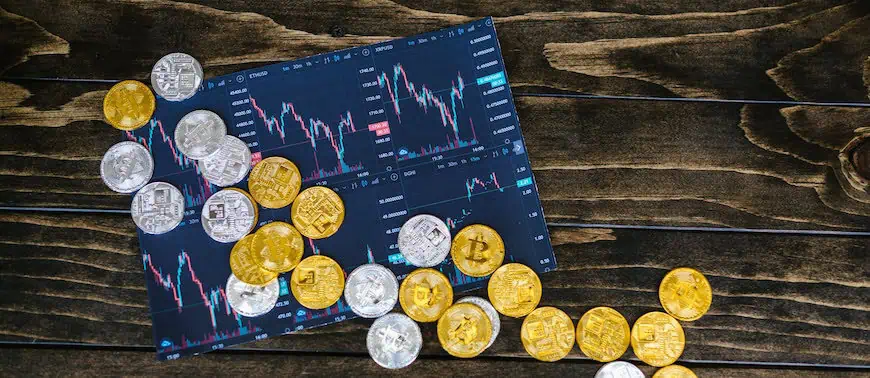Leverage is a concept commonly known by experienced traders. It is used by traders who want to trade large-value contracts with minimal amounts. Just as it is used in forex or stocks, it can also be used in cryptocurrency trading.
Understanding this tool can be a great way to gain success in crypto trading. In this article, we will take a comprehensive look at how leverage trading works in the crypto space, strategies to maximize tom minimize risk and increase profits as well as its pros and cons.

Leverage trading in crypto
Leverage is a financial tool that enables a trader to borrow funds from a crypto exchange or trading platform that can be used to expand a trading position beyond the limits of capital. Simply put, with leverage trading one can control larger amounts of cryptocurrency than what they have deposited in their trading account.
This new trading capacity allows traders to increase possible earnings from price fluctuations in the underlying assets without having to spend the whole value of the position. For instance, if a trader has $2,000 in cryptocurrency and uses a 2x leverage ratio, they may open a position for $4,000.
Margin Trading
It is important to understand margin trade and though it is sometimes used interchangeably with leverage trading the two are different. Leverage is more of an instrument that facilitates margin trading.
When trading, a trader can borrow funds from a trading platform or brokerage firm to carry out trades. However, they are required to maintain a certain amount of personal funds in their trading account as collateral. This is what we call margin.
Leverage focuses on the percentage of borrowed cash to capital. The leverage ratios show how the trader’s margin amplifies the deal size. Common leverage ratios in cryptocurrency trading include 2x, 5x, and 10x, with some trading platforms providing even greater ratios.
High leverage ratios can boost profits. Unfortunately, they also involve higher risks and larger losses. As a result, this trading approach needs diligent risk management. This is why leverage trading is unsuitable for inexperienced traders or those with a low-risk tolerance.
How leverage trading in crypto works
Before embarking on leverage trading and placing your collateral, you must assess the current market situation. This is because potential losses in leverage can be substantially high.
As already mentioned, you need initial capital which you will use as your collateral deposit. This collateral deposit is determined by the leverage ratio you wnat to use and the position size you want to set.
To optimize profits, a trader needs to uphold a designated margin, known as the maintenance threshold or maintenance margin. This amount must be retained in the trading account to prevent the risk of losing funds through liquidation. In the event of adverse market movements against your position causing a decrease in your margin, you’ll be required to make additional deposits to sustain the required margin.
Funding your account
Regardless of the trading platform or exchange you use, you must put collateral into your account. The particular collateral amount is determined by your leverage ratio and position size.
The higher your leverage ratio the higher the risks. Therefore, you have to evaluate your risk tolerance before choosing a leverage ratio. You can also employ risk management strategies, which we shall discuss below. These strategies will help protect you from the fallout from huge losses.
Opening trading positions
Leverage allows traders to open both long positions (anticipating a price increase) and short positions (anticipating a price decrease), allowing them to profit from market movements despite their asset price predictions.
In both cases, leverage empowers traders to maximize potential profits by opening positions that exceed their own capital restrictions.
Leveraged Tokens
Leveraged tokens are cryptocurrencies that provide traders with more exposure to an underlying asset’s price movements without the need for direct collateral. This eliminates the risk of liquidity.
These tokens are designed to simplify the process of multiplying gains from token price movement, making it more accessible to users on various cryptocurrency exchanges.
For example, consider a 2X long leveraged token linked to Bitcoin (BTC), which aims to deliver twice the percentage change in BTC’s price movement. If the BTC price rises by 5%, the 2X long leveraged token for BTC would increase by 10%. On the other hand, if the price of BTC falls, the 2X long leveraged token would decrease by 10%.
Leveraged tokens stand out as some of the riskiest securities in the cryptocurrency industry, owing to their high volatility. They cannot be withdrawn to your wallet should the market fall. They are also vulnerable to volatility decay and rebalancing mechanisms. They also attract extra fees to trade.
Nonetheless, when used correctly, leveraged tokens may boost a trader’s profitability and enable access to higher-value investments. They also serve as a technique for profiting from token price reductions and cryptocurrency market downturns.
Leveraged tokens can be used by traders to protect their holdings from price declines. If you’re looking at leverage tokens, cryptocurrency exchanges like Binance enable both leverage trading and leveraged tokens.
Leveraged trade example
Assume a trader deposits $1,000 of Binance Coin (BNB) and uses a 5x leverage, resulting in $5,000 in purchasing power. With this, they purchase $10,000 worth of Ether at a price of $5,000 per coin. If the price of Ether increases to $8,000 per token, exiting the investment now would result in a $3000 profit. It is vital to note that fees will be subtracted from the profit figure.
Benefits of leverage trading
Leverage in cryptocurrency trading offers several benefits.
Capital diversification. Leverage trading allows you to maintain smaller amounts of capital in your accounts while still taking significant positions. This means you can use your funds to diversify your investments.
Increased earnings. Leverage trading appeals to many traders due to its potential for substantial profits. Even little price swings might result in substantial rewards. Furthermore, by expanding purchasing power, traders can open greater positions than their own money allows, maximizing their profit potential.
You can benefit from market volatility. There are times when the market presents trading opportunities that demand significant resources to execute on. Leverage allows traders to seize these opportunities without making a large initial commitment, making it an effective instrument for benefitting from short-lived market situations.
Exposure to the cryptocurrency market. Leverage trading enables consumers to engage in a variety of trading pairings, increasing their engagement in the volatile cryptocurrency market.
Hedging using leverage. Experienced traders can use leveraging positions to hedge against other investments. For example, if the long-term perspective for ETH is optimistic but the short-term forecast is for a decrease, starting a leveraged trading short position becomes a reasonable strategy. This technique provides the opportunity to profit from the short-term fall while keeping the original asset.
Drawbacks of leverage trading
Leverage presents a myriad of opportunities for traders. Nevertheless, it has some drawbacks.
Amplified losses. While leverage has the potential to increase earnings, it also multiplies possible losses. If the market goes in the desired direction, profits are compounded. Conversely, if the market moves against the trader, losses are also intensified. This inherent duality emphasizes the importance of careful risk management and strategic decision-making when engaging in leveraged trading.
Market Volatility. Cryptocurrency markets are notorious for their volatility. Leverage trading in these markets might result in unanticipated price changes. This can make it difficult to accurately predict price movements.
Complexity. Leverage trading has a learning curve. It involves complex financial instruments and strategies that new traders may find challenging. If not understood well, the chances of costly mistakes increase.
Risk of liquidation. One of the most significant losses you might incur while leverage trading is the possibility of liquidation if the market swings negatively.
Fees. Leveraged trading often involves fees, including interest on borrowed funds and trading fees. These costs can eat into profits and should be considered when engaging in leveraged positions.
Security concerns. Many crypto traders are concerned about breaches and hacks. Because leverage trading needs the deposit of funds in an exchange, the danger of fund loss is increased.
Lack of regulation. Cryptocurrency operates in a decentralized environment, which means the ecosystem is uncontrolled. This absence of regulation may expose traders to fraudulent or manipulative behavior.
Before incorporating leverage trading into the crypto market, it is critical to get a thorough understanding of how it works.
Risk management strategies
Leveraged trading is inherently risky, Nonetheless, you can employ certain risk management strategies to navigate and protect yourself when trading.
Set stop-loss orders
Stop-loss orders are automatic orders that limit potential losses. If the asset price falls below a set level, the platform will immediately sell, averting further loss. The fundamental goal of a stop-loss order is to minimize possible losses by exiting a losing position before the losses get too large. It enables traders to stick to their risk tolerance and prevent huge capital losses.
Set take-profit orders
A take-profit order is used in leverage trading to automatically cancel a trade when the market hits a predetermined profit threshold. This order allows you to continuously maintain your profits without having to constantly check the market.
Take-profit orders are frequently used alongside stop-loss orders, and when combined, they help you apply a disciplined trading approach while also managing gains and losses more efficiently.
Trend following
The method involves identifying current market trends and aligning your trading strategy accordingly. For example, in a bullish market, a trader will open long positions whereas in a negative market, he will open short positions.
Using trend following with leverage may be a profitable technique provided you educate yourself and understand the market’s complexity well.
Position sizing
Position sizing in leverage crypto trading is the process of determining how much cryptocurrency a trader will purchase or sell in a certain deal. It entails determining the quantity of the item to be exchanged, as well as the level of leverage used in the deal.
To calculate position sizing in leverage trading
Position Size=Leverage Ratio (Trading Capital×Risk Percentage)
Where:
Position Size: The crypto to be traded.
Trading Capital: The total capital you will use for trading.
Risk Percentage: The percentage of the capital you are willing to risk on the trade.
Leverage Ratio: The chosen level of leverage.
Position sizing is crucial in leverage trading to manage risk and prevent significant losses.
Asset diversification
You have probably heard the famous saying do not put all your eggs in one basket. The same applies to leverage trading. Spreading your investments across diverse crypto assets will help you reduce any negative impact should there be a loss.
Limit Leverage
You do not have to go for teh highest leverage ratio offered by a trading platform. Always start with a lower ratio and build your way up as you gain experience with leverage trading.
Educate yourself
Leverage trading is a bit technical. Ongoing learning and consistent practice are essential for successful leveraged crypto trading. Keep up to date with market trends as this will help refine your trading skills. Learn from any mistakes you make along the way to avoid a negative cycle of losses.
Monitor your positions
Leveraged positions require you to be vigilant and regular monitoring of your positions will help you adjust quickly when the need arises.
Choosing the right platform
A trading platform can positively or negatively affect your leverage trading strategies. Different platforms have different ratios and trading features like margin trading, futures contracts, and leveraged tokens we talked about earlier.
On top of that, some platforms have restrictions on trading options. Choose a platform that meets all necessary regulatory considerations, including licensing, regulation, and compliance. This will help you avoid a negative trading experience in your country.
By comparing different platforms and leverage ratios, you can choose a platform that suits your risk tolerance and long-term trading goals.
Bottom line
Leveraging trading in crypto can help significantly increase your profits. As rewarding as it may be, you need to understand the potential risks that come with it and employ the necessary risk management techniques to protect your assets.
Disclaimer: Investing can be quite a wild ride – especially when you don’t know the terrain! To keep things from getting too rocky, take some time beforehand to get familiar with all of the risks involved. Our site is here to up your investor game by providing all available intel about platforms and trends, but we don’t take responsibility nor can we be held accountable as advisors. That being said, it’s still important for you to make educated decisions that match what works best for YOU – just remember: no amount of savvy will guarantee success or protect against loss so invest money you can spare.











